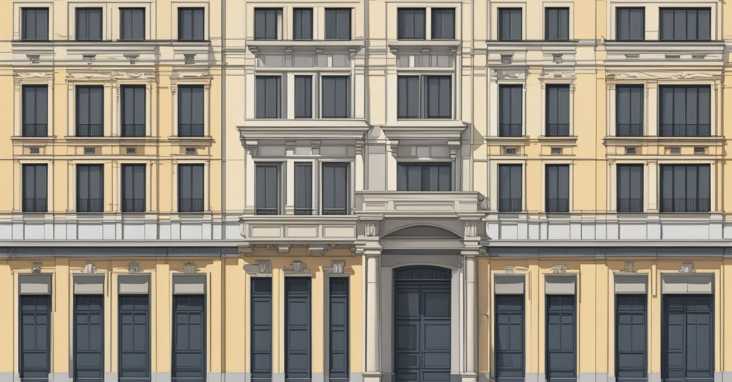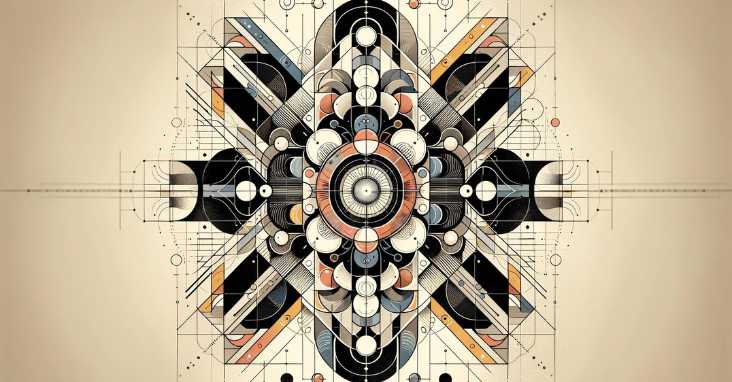How to achieve symmetrical balance? Use mirrored elements across a central axis, evenly distribute weight, and align objects for visual symmetry and balanced design aesthetics.
Symmetrical balance is a fundamental principle of design that is widely used in various fields, including art, architecture, and graphic design. It is a type of balance where the elements of a composition are evenly distributed on either side of a central axis. This creates a sense of harmony and stability, making it a popular choice for creating visually pleasing designs.

One of the key principles of design is balance, which refers to the distribution of visual weight in a composition. Symmetrical balance is one of the ways to achieve balance, where the elements on either side of the central axis are identical or nearly identical. This creates a sense of order and stability, making it an effective way to create a visually pleasing design.
Symmetrical balance is commonly used in art, architecture, and design, and it can be found in many different forms. From the intricate patterns of Islamic architecture to the simple, elegant designs of Scandinavian furniture, symmetrical balance is a versatile principle that can be applied in many different ways.
Key Takeaways
- Symmetrical balance is a fundamental principle of design that creates a sense of harmony and stability.
- It is achieved by distributing elements evenly on either side of a central axis.
- Symmetrical balance is commonly used in art, architecture, and design to create visually pleasing compositions.
Principles of Design
Understanding Balance
Balance is a fundamental principle of design that is essential in achieving a visually pleasing and harmonious composition. It refers to the distribution of visual weight in a design, and how the elements in the design relate to one another. Achieving balance in a design can be done through symmetrical or asymmetrical balance.
Symmetry vs. Asymmetry
Symmetrical balance is achieved when the elements in a design are arranged in a way that creates a mirror image on either side of a central axis. This type of balance is often used in traditional art and design, as it creates a sense of stability and order. Asymmetrical balance, on the other hand, is achieved when the elements in a design are arranged in a way that creates an overall sense of equilibrium, despite not being identical on either side of a central axis. This type of balance is often used in modern and contemporary art and design, as it creates a sense of movement and tension.
Visual Weight and Equilibrium
Visual weight refers to the perceived importance or prominence of an element in a design. It can be influenced by factors such as color, size, and texture. Achieving equilibrium in a design involves balancing the visual weight of the elements in a way that creates a sense of stability and order. This can be done through careful placement and arrangement of the elements in the design.
When it comes to achieving balance in a design, there are several key factors to consider. These include the structure and order of the design, the use of axis and symmetry, the aesthetic qualities such as color and line, and the use of formal balance and proportion. By carefully considering these factors, designers can create visually pleasing and harmonious compositions that are both beautiful and functional.
For more information on the principles of design and achieving balance in art and design, check out this resource.
Symmetrical Balance in Art
Symmetrical balance is a fundamental principle of art that has been used by artists for centuries. It is a type of balance in which the elements of a composition are arranged in a way that creates a mirror image on either side of a central axis. This creates a sense of stability and harmony in the artwork.
Historical Significance
Symmetrical balance has been used in art throughout history, from classical Greek and Roman architecture to the Taj Mahal in India. One of the most famous examples of symmetrical balance is Leonardo da Vinci’s Vitruvian Man, which depicts a man with his arms and legs outstretched in a perfect circle and square.
In painting, symmetrical balance was often used in religious art to convey a sense of order and harmony. Vincent van Gogh’s painting “The Starry Night” is an example of symmetrical balance, with the cypress tree and the village on either side of the painting creating a mirror image.
Analyzing Symmetrical Compositions
When analyzing a symmetrical composition, it is important to consider the placement of the elements in the artwork. Are they perfectly mirrored, or are there subtle differences that create interest and movement in the piece? Is the central axis vertical or horizontal, and how does this affect the overall balance of the composition?
One way to analyze symmetrical compositions is to create a grid and compare the placement of the elements on either side of the central axis. This can help to identify any subtle differences and create a deeper understanding of the artwork.
For more information on symmetrical balance in art, visit the National Gallery of Art’s website, which provides an in-depth lesson plan on the topic.
Asymmetrical Balance in Design
Asymmetrical balance is a technique used in design to create a sense of equilibrium without using mirror images. Instead of relying on symmetry, asymmetrical balance uses different elements to achieve balance. This approach is often used in modern design, where designers aim to create a sense of dynamism and movement in their work.
Modern Implications
Asymmetrical balance has become increasingly popular in modern design, particularly in the realm of graphic design. This is because it allows designers to create a more dynamic and interesting composition, which is better suited to the fast-paced nature of modern life. Asymmetry can be used to create a sense of movement, direction, and energy in a design, which can be very effective in catching the viewer’s attention.
Creating Dynamic Asymmetry
Creating dynamic asymmetry requires careful consideration of the visual weight and direction of the elements used in the design. Visual weight refers to the perceived “heaviness” of an element, while visual direction refers to the direction in which the element appears to be moving. By balancing these elements in a way that creates a sense of equilibrium, designers can achieve a dynamic and engaging composition.
One example of asymmetrical balance is the use of negative space in a design. By leaving some areas of the design empty, designers can create a sense of balance and harmony in the composition. This technique is often used in wedding invitations, where the negative space can be used to draw attention to the text or other important elements of the design.
In conclusion, asymmetrical balance is a powerful tool in modern design. By using different elements to create a sense of equilibrium, designers can create dynamic and engaging compositions that catch the viewer’s attention. Asymmetry can be used to create a sense of movement, direction, and energy, which is particularly effective in the fast-paced world of modern design. For more information on asymmetrical balance, check out this resource, which provides a detailed overview of the topic.
Applications in Architecture

Symmetrical balance has been a fundamental concept in architecture for centuries. Architects use it to create structures that are visually appealing and stable. This section explores how symmetry is applied in architecture.
Incorporating Symmetry
Symmetry is often used in architecture to create a sense of balance and harmony. One of the most famous examples of symmetrical architecture is the Taj Mahal. It is a perfect example of how symmetry can be used to create a visually stunning building. The Taj Mahal is symmetrical in every way, from the placement of the minarets to the layout of the gardens.
Symmetry can also be used to create a sense of stability in a building. When a building is symmetrical, it gives the impression that it is well-balanced and structurally sound. This is because symmetrical buildings have a central axis that runs through the middle of the structure. This axis helps to distribute weight evenly, making the building more stable.
Balancing Asymmetrical Structures
While symmetry is often used in architecture, there are times when asymmetry is more appropriate. Asymmetrical structures can be just as visually appealing as symmetrical structures, but they require a different approach to achieve balance.
Architects use a technique called radial balance to create balance in asymmetrical structures. Radial balance involves arranging elements around a central point in a circular pattern. This helps to create a sense of balance and harmony, even in asymmetrical structures.
When designing an asymmetrical structure, architects must also consider the placement of elements. By carefully placing elements, they can create a sense of balance and harmony, even without symmetry.
In conclusion, symmetrical balance is an important concept in architecture. It is used to create visually stunning and structurally sound buildings. While symmetry is often used, there are times when asymmetry is more appropriate. By using techniques such as radial balance and careful placement of elements, architects can create balance and harmony in both symmetrical and asymmetrical structures.
Here is an external resource that discusses the importance of symmetry in architecture.
Symmetry in the Natural World

Symmetry is a fundamental concept in the natural world, and it is found in various forms throughout the universe. From the symmetry of snowflakes to the symmetry of human faces, symmetry is a crucial aspect of the natural world. In this section, we will explore the different forms of symmetry found in nature.
Biological Symmetry
Biological symmetry refers to the symmetry found in living organisms. The most common form of biological symmetry is bilateral symmetry, which is found in animals that have a distinct left and right side. Examples of animals with bilateral symmetry include butterflies, which have two symmetrical wings, and humans, who have a symmetrical face.
Another type of biological symmetry is radial symmetry, which is found in animals that have a circular or radial body plan. Examples of animals with radial symmetry include starfish and jellyfish. These animals have multiple planes of symmetry and can be divided into identical halves in several ways.
Natural Patterns and Structures
Symmetry is also found in natural patterns and structures. For example, trees exhibit a form of symmetry known as fractal symmetry, which is a repeating pattern that looks the same at different scales. The branches of a tree exhibit this type of symmetry, with each branch dividing into smaller and smaller branches that resemble the larger branch.
Another example of natural symmetry is found in the sun. The sun exhibits rotational symmetry, with its surface appearing the same when rotated around its axis. This type of symmetry is also found in snowflakes, which have six-fold rotational symmetry due to the hexagonal shape of their crystals.
In conclusion, symmetry is a fundamental aspect of the natural world, and its presence can be observed in various forms. From biological symmetry to natural patterns and structures, symmetry is an essential component of the universe. To learn more about symmetry in the natural world, check out this article by National Geographic.
Cultural and Conceptual Aspects

Symbolism of Balance
Symmetrical balance has been used in many cultures as a symbol of stability and formality. In Chinese culture, the yin and yang symbol represents the balance between opposing forces. The symbol is made up of two halves, one black and one white, which are mirror images of each other. This balance is essential to the concept of harmony in Chinese culture. Similarly, in Hinduism, the mandala is a symmetrical design that represents the universe and the balance between opposing forces. The mandala is often used in meditation to bring balance and order to the mind.
Perception of Beauty and Order
Symmetrical balance is often associated with beauty and perfection. The human brain is wired to find patterns and symmetry pleasing to the eye. This is why symmetrical designs are often used in art, architecture, and fashion. However, pure symmetry can also be seen as boring or uninteresting. Asymmetrical balance, which is a balance between different elements rather than mirror images, can create a more dynamic and interesting design.
In some cultures, symmetry is associated with the right side of the body, which is considered to be dominant. In Western cultures, left-handedness was once seen as a sign of evil or weakness, and left-handed people were forced to use their right hand. However, this perception has changed over time, and left-handedness is now seen as a unique trait.
Overall, symmetrical balance has played an important role in many cultures and has been used to represent concepts such as stability, formality, and beauty. However, it is important to remember that balance can also be achieved through asymmetry and that different cultures have different perceptions of what is considered beautiful or orderly.
Here is an external resource with more information on the topic of symmetry and its role in art and design.
Technical Considerations

Measuring and Adjusting Balance
Achieving symmetrical balance in a design requires careful attention to detail. One way to measure balance is to use a grid system to divide the picture plane into equal sections and ensure that each section contains an equal amount of visual weight. Another method is to use a mirror to reflect the design and check for symmetry. Adjustments can be made by adding or removing elements, adjusting their size or position, or changing their color or texture.
Design Tools and Techniques
Designers have a variety of tools and techniques at their disposal to create balanced compositions. One common approach is to use an axis, such as a vertical or horizontal line, to divide the design into equal halves. Another technique is to use proportion to create balance, such as by using the golden ratio or other mathematical principles. Negative space can also be used to create balance by providing a visual counterpoint to the main elements of the design.
Copy and diagrams can also play a role in creating balance. For example, repeating patterns or shapes can create a sense of equilibrium, while contrasting elements can create tension. Designers can also use color theory to create balance, such as by using complementary colors or creating a monochromatic color scheme.
Overall, achieving symmetrical balance requires careful attention to detail and a variety of design tools and techniques. By understanding the principles of balance and using them effectively, designers can create visually compelling and harmonious compositions.
Here is a resource with more information on design theory and techniques.
Frequently Asked Questions

How do you define symmetrical balance in art and design?
Symmetrical balance is a design principle that involves dividing a composition into equal parts on either side of a central axis. This results in a mirror-like effect where one side of the composition is a reflection of the other. The goal is to create a sense of stability, harmony, and order in the design.
Can you provide examples of symmetrical balance in everyday objects?
Symmetrical balance can be found in many everyday objects such as buildings, furniture, and even the human body. A prime example is the face, which is often considered the most symmetrical part of the body. Other examples include a perfectly round ball, a symmetrical vase, and a symmetrical building facade.
What distinguishes symmetrical from asymmetrical balance in visual composition?
The main difference between symmetrical and asymmetrical balance is that symmetrical balance involves dividing a composition into equal parts, while asymmetrical balance involves creating balance through the use of different visual elements such as color, texture, and shape. Asymmetrical balance is often more dynamic and can create a sense of movement and energy in the design.
How does symmetrical balance contribute to the overall aesthetics of a design?
Symmetrical balance can contribute to the overall aesthetics of a design by creating a sense of order and harmony. It can also make the design feel more stable and grounded. However, too much symmetry can also make a design feel static and boring, so it’s important to use it in moderation and balance it with other design principles.
What are the differences between symmetrical balance, asymmetrical balance, and radial balance?
Symmetrical balance involves dividing a composition into equal parts on either side of a central axis, while asymmetrical balance involves creating balance through the use of different visual elements. Radial balance, on the other hand, involves arranging visual elements around a central point. While symmetrical and asymmetrical balance create a sense of stability, radial balance can create a sense of movement and energy in the design.
In what ways can symmetrical balance be effectively implemented in drawing and illustration?
Symmetrical balance can be effectively implemented in drawing and illustration by using a central axis and dividing the composition into equal parts. This can be achieved through the use of symmetry tools in digital software or by sketching out the design with a ruler and compass. It’s important to keep in mind that symmetry can make a design feel static, so it’s important to balance it with other design principles such as contrast and texture.
One external resource that provides more information on symmetrical balance in art and design is this article from Adobe: Symmetrical Balance in Design: What It Is and How to Use It.
Compare hundreds of Business Graphics Software in our Software Marketplace















